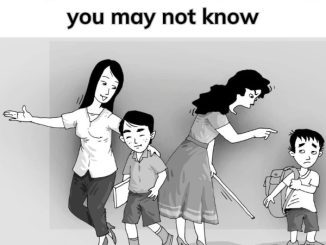Those who were born and raised in rural areas in the past are certainly no stranger to the image of farmers tirelessly pedaling rice threshing machines during each harvest season. That day, after cutting, the rice was stacked in bundles in the field to dry, then stretched around to thresh. The wealthier families carry rice by buffalo or cow or carry the rice home with a two-headed shock and then step on a threshing machine.
My grandmother’s family bought a rice threshing machine so it was less difficult every harvest season. We children often hang around the threshing machine to watch the adults threshing rice. When the rice was finished threshing, we gathered together to make the machine spin and laugh happily.

In recent years, when large sample fields were formed, the intra-field transportation system was expanded, rice harvesters powered by engines, and then combine harvesters appeared. Since then, harvesting and transporting rice to farmers’ homes is very convenient. Rice threshing machines, which were worth a fortune to people in the past, are gradually being forgotten, and it is not easy to find human-powered threshing machines in rural areas in the past.
Rice threshing machines are usually made up of 3 parts: The machine body is made of metal, standing firmly on a block adjacent to the ground. On the upper part of the frame, there are usually two “machine ears”, also known as eyelets, which are points to attach sticks for two people to carry and move the machine. In addition, these two ears also have the side effect of keeping the threshing drum steady at the end of the harvest season, by tying 2 iron teeth to the two machine ears with string, then the threshing drum will be fixed in case children I’m joking.
The plucking drum is usually made of wood, has a circular cylinder in a horizontal position, is made of many drums assembled, hollow inside. On the drum pieces, people install offset iron teeth. The drum rotates thanks to the power of people kicking. These iron teeth are the main factors that impact the rice flower to separate the grain from the flower. The pedal is usually made of metal or wood, where foot force is directly used to rotate the pulley, thereby causing the threshing drum to rotate strongly, creating force to thresh rice. When you use your foot to step on the pedal, the two gears will mesh together, creating force to rotate the drum.

The foot-pedaled rice threshing machine is being kept and preserved at the Provincial Museum. Photo: Huynh Ba Tinh
The foot-pedaled rice threshing machine is being kept and preserved at the Provincial Museum. Photo: Huynh Ba Tinh
When operating, the user must use a tarpaulin to cover the front of the threshing machine or panels to keep the rice from flying out. The pedaler’s hands will grasp the roots of rice handfuls that can fit in two hands, not too thick so that the machine cannot thresh away the grains. At that time, the drum teeth separate the seeds from the cotton and throw them forward. The operator firmly holds the rice at the base and rotates continuously so that the entire flower comes into contact with the rotating set of teeth. While the hands perform the task of shuffling the rice, the thresher’s feet still have to use force and step continuously to create force for the ball bearing and threshing drum to rotate.
For each stage of agricultural development, there will be typical labor tools for that stage. And so is the rice threshing machine, which is a transitional stage between the manual threshing of rice in the previous period and the modern engine-powered threshing machines of the present period.
Preserving traditional tools helps the next generation to appreciate the creativity of our ancestors, through working tools that show part of the hard work of agricultural residents to give us rice grains – pearls of nature.


